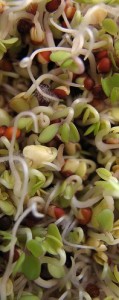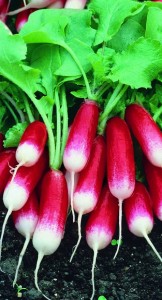 My household is a hurricane-ready one. We have plans for food, water, and several options for providing power in the event of another hurricane hitting this area. We went through several before, so have some idea what the aftermath is like, so can plan for many things we know may occur.
My household is a hurricane-ready one. We have plans for food, water, and several options for providing power in the event of another hurricane hitting this area. We went through several before, so have some idea what the aftermath is like, so can plan for many things we know may occur.
As to the food part of the equation, we have enough canned goods to get us through, but that gets old pretty quick. Fresh food tastes better, and offers better nutrition, an important thing in times of stress.
I have several quick-fix options up my sleeve for providing fresh produce after a major storm. Since heavy winds and/or rain will more than likely decimate my yard, my garden beds will require rebuilding before they can be replanted, and 50-60 days for many crops to be ready for harvest. We would be wanting fresh food far sooner than that.
Here is my thoughts on the quickest way to get fresh foods into our diet. These work most any time of the year, and can be applied to any area, with some modifications.
 Sprouts. Some seeds store very well long-term (allegedly, wheat found buried with Egyptian mummies was sprouted centuries later, however, this was later found to be a scam to sell seeds). Viability charts for seeds show that most are viable for 2-5 years, if stored in a cool, dry area out of direct sunlight. You multiply that by a factor of 4 or 5 if you freeze those same seeds, making sure they are very dry first, 8% moisture content or less.
Sprouts. Some seeds store very well long-term (allegedly, wheat found buried with Egyptian mummies was sprouted centuries later, however, this was later found to be a scam to sell seeds). Viability charts for seeds show that most are viable for 2-5 years, if stored in a cool, dry area out of direct sunlight. You multiply that by a factor of 4 or 5 if you freeze those same seeds, making sure they are very dry first, 8% moisture content or less.
On top of that, yields are range from 1:2 to 1:7 in seed to resulting sprouts…Thus in the case of radish seeds (a sharp, peppery taste that is popular in our house) you get a yield of 1:7…a pound of seeds gives you seven pounds of sprouts.
This means a one pound bag of radish seeds can sit on the shelf for 5 years, yield seven pounds of sprouts, and in a pinch can also be planted to give radish roots and tops for eating.
This leads us to our second long-term storage option for quick-yield vegetables in an emergency, radishes.
 Radish seeds can not only be sprouted to consume, but can also grow into a harvestable root vegetable in a matter of a few weeks. The Cherry Belle and the French Breakfast radishes are harvestable in as little as 20 days! For those of you that do not like the spicy bite of radishes, try roasting them. Roasting cools the spiciness, and gives a a nice buttery turnip-like flavor. (The buttery part may be due to the butter I cook them in, though…don’t omit it!)
Radish seeds can not only be sprouted to consume, but can also grow into a harvestable root vegetable in a matter of a few weeks. The Cherry Belle and the French Breakfast radishes are harvestable in as little as 20 days! For those of you that do not like the spicy bite of radishes, try roasting them. Roasting cools the spiciness, and gives a a nice buttery turnip-like flavor. (The buttery part may be due to the butter I cook them in, though…don’t omit it!)
And don’t forget to save the tops from the radishes, they work nicely as a cooked green…and that’s the whole reason we are talking here, right? Getting fresh vegetables into our diets in a pinch.
Speaking of greens, my final option is leaf vegetables, both domestic and wild.

Domestic greens besides the radish tops mentioned above, can include turnips (for the tops, roots take much longer), leaf lettuces, baby spinach, and certain varieties of Asian greens. ANY leaf lettuce can be harvested before maturity, but some just grow faster. I’ve had good results with Mesclun, a mixed variety of various leafy greens grown for salads, and usually harvested while young and tender. Call it “fancy” salad, if you will. Many of those listed here on Amazon are harvestable in as little as 21 days. One of the great things about these types of plants is if you cut the tops off (I use scissors), mowing like grass, you will get new growth you can harvest again in a week or two. You can repeat this many times before the plants give up. If you stagger your plantings by a few weeks, you can have a rotational salad factory that is virtually endless! (Weather permitting. You may need to do this indoors in a Earthbox, or something similar. A future post will be how to make your own self-watering planter that is very close to an Earthbox, at about 1/4 the cost.)
Wild foraging can produce a huge variety based on season and locale, however require some training that can take years to perfect. Remember, you are putting what you pick into your body…you should really be sure what it is.
I’d suggest a good local book, and then a good local forager, preferably an old one that has been doing it their whole life. Anyone that has made it to old age while foraging has probably made very few mistakes.
(Here in South Florida, I can recommend Green Dean, though I wouldn’t consider him “old”. His knowledge of wild edibles is impressive, as is the fact that he won’t hesitate to tell you he doesn’t know something when he doesn’t. A Teacher than can admit the lack of knowledge in their own specialty shows that they, too, are still students.)
====================
So, in a pinch, if we get hammered by Old Man Murphy somehow, I’ll start with a batch of sprouts, harvesting my first ones in 2-3 days.
At the same time, I’ll put in a patch of leafy greens of various sorts, depending on the season, as well as some Cherry Belle and French Breakfast radishes.

And while I’m out and about, I’ll keep my eyes peeled for various wild edibles that I’m already very familiar with, such as purslane, sea purslane, Spanish needles, Poor Man’s pepper grass, and something I look for all the time already, smilax. (Smilax sauteed in butter with a bit of lime and garlic tastes a LOT like asparagus to me. YUM!)
While I’m doing all this, I won’t have to worry about food as much, and can also ramp up the longer growing vegetables that do well in my area.
The seeds are already in my “kit”. I have a plan.
Just in case…
Peace,
db

I made few really simple sprouters out of 2 plastic stackable cups and a lid from a jar of instant coffee. You get more than enough sprouts in one set up in 3 days to double the volume of a can of progresso soup. So with 3 you can have a batch of sprouts every day. I have made sprouts from several beans / seeds such as lentils (10 years+ old) mung beans, black eyed peas, garbanzo beans etc (I don’t like pinto beans):
http://www.instructables.com/id/Make-This-Sprouter-It-Works-Great/?allstep
Lux
Being Paleo, I stay away from legumes (and grains, btw), even sprouted ones. I prefer radish, broccoli, mustard and want to try onion seeds eventually.
I do like the rotating sprouters to keep a steady supply of sprouts available.
When I sprout, I usually just use a quart mason jar with a bit of clean pantyhose over the top.
db